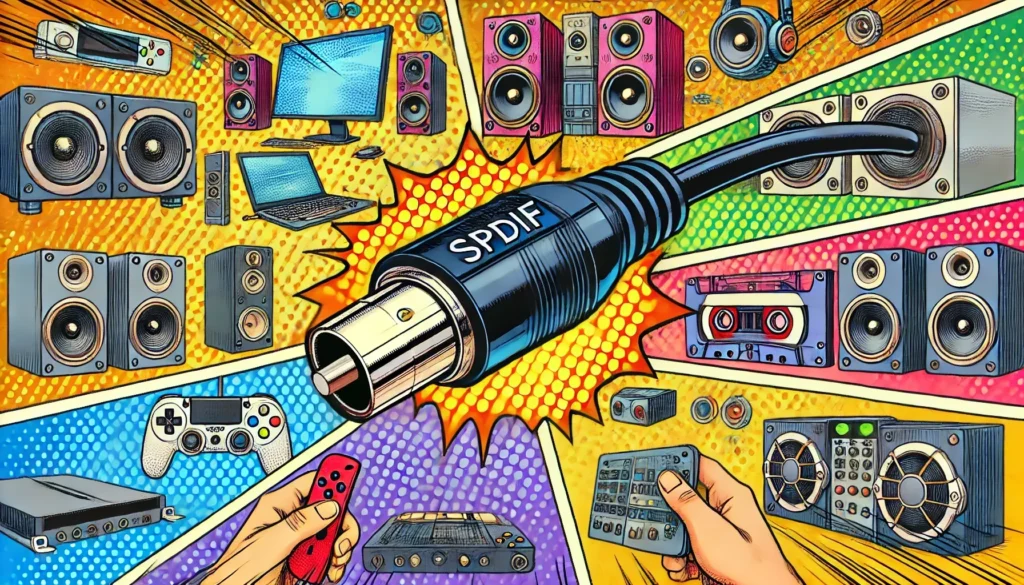SPDIF (Sony/Philips Digital Interface Format) is a widely used digital audio interface that transmits high-fidelity audio between devices. It’s an essential technology for audio enthusiasts and professionals alike, enabling the transfer of digital audio signals without the loss of quality associated with analog connections. This guide provides an overview of SPDIF, explaining its functionality, benefits, and common uses.
Table of Contents
1. What is SPDIF?
Developed jointly by Sony and Philips, SPDIF is a standard for digital audio transmission. It uses a physical cable (coaxial or optical fibre) to transmit audio data in digital form. SPDIF is commonly found in consumer audio equipment, home theatre systems, and professional audio setups, allowing for the transfer of stereo or multichannel audio through a single connection.
2. Key Features of SPDIF
- High-Quality Audio Transmission: SPDIF preserves audio quality by transmitting data in a digital format, avoiding the noise and distortion that can occur with analog signals.
- Simple Connectivity: It typically requires only a single cable, which can be either coaxial (using RCA connectors) or optical (using TOSLINK connectors).
- Support for Multiple Audio Formats: SPDIF can transmit two channels of uncompressed PCM audio or support for compressed 5.1/7.1 surround sound formats like Dolby Digital and DTS.
3. How Does SPDIF Work?
SPDIF transmits audio data using a method called “Pulse Code Modulation” (PCM). This process involves the following steps:
1. Sampling: The analog audio signal is sampled at regular intervals (usually 44.1, 48, or 96 kHz).
2. Quantization: Each sample is converted into a digital number at a certain bit resolution (commonly 16 or 24 bits per sample).
3. Encoding: The digital data is then encoded into a format suitable for transmission and sent through the SPDIF interface.
During transmission, the data is sent as a stream of digital bits. This stream includes both the audio data and additional bits for synchronization and error detection, ensuring that the audio is transferred accurately.
4. Applications of SPDIF
- Home Theatre Systems: SPDIF is used to connect audio/video receivers, DVD/Blu-ray players, and compatible speakers, facilitating high-quality audio playback.
- Computers and Game Consoles: Many sound cards and gaming consoles use SPDIF to connect to audio processors or home theatre receivers.
- Professional Audio Equipment: SPDIF interfaces are common in professional audio equipment, enabling high-quality audio recording and playback without the artifacts associated with analog connections.
5. Benefits of Using SPDIF
- Clarity and Quality: Digital transmission minimizes the chances of signal degradation and interference, maintaining the clarity and quality of the original audio signal.
- Ease of Installation: With SPDIF, audio setup is simplified to connecting a single cable, avoiding the clutter and complexity of multiple analog cables.
- Compatibility: SPDIF is widely supported across a variety of devices, making it a universal solution for digital audio connections.
6. Challenges with SPDIF
- Distance Limitations: SPDIF signals, especially over optical cables, can degrade over long distances, typically effective up to 10 meters without signal boosting.
- Limited Channel Capacity: SPDIF is limited to two channels of uncompressed PCM audio or compressed 5.1/7.1 audio, which may not suffice for setups requiring full uncompressed multichannel audio (such as some modern home theatres or audio production environments).
Final Thoughts
SPDIF remains a crucial interface in digital audio applications, providing a straightforward, high-quality method for transmitting audio signals between devices. Whether setting up a home theater system, configuring a computer audio station, or connecting professional audio equipment, SPDIF offers a reliable and efficient means of handling digital audio.
